

An encyclopedia of Middle-earth and Numenor

|
|
|
|
|
|
|
|
|
|
|
|
|
|
| |
|
 |

An encyclopedia of Middle-earth and Numenor |
 |

Barad-dûr, The Dark Tower |
Top:
Map of Barad-dur
Bottom: Barad-dur in the New Line film |
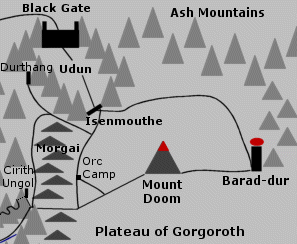 Stronghold
of Sauron in Mordor.
Barad-dur was at the end of a long spur of the Ash
Mountains on the northern border of Mordor. The tower overlooked the
plateau of Gorgoroth. A road led northwest
from Barad-dur to the Black Gate,
about 100 miles away.
Stronghold
of Sauron in Mordor.
Barad-dur was at the end of a long spur of the Ash
Mountains on the northern border of Mordor. The tower overlooked the
plateau of Gorgoroth. A road led northwest
from Barad-dur to the Black Gate,
about 100 miles away.
Mount Doom was about 30 miles directly west of Barad-dur. Sauron's Road ran from the western gate of Barad-dur over an iron bridge spanning an abyss and then across Gorgoroth to the eastern slopes of Mount Doom.
Barad-dur was an immense fortress of immeasurable strength. It was made of iron and extremely hard stone and its gates were steel. The tower was black and it was wreathed in veils of shadow woven by Sauron. It was very tall with many walls, battlements, and towers.
The highest tower was topped with an iron crown and in it was the Window of the Eye from which Sauron gazed. Within the Dark Tower were great courts and an armory and windowless dungeons; and beneath the tower were deep pits.
Sauron began building Barad-dur around the year 1000 of the Second Age, when he chose Mordor as his realm. The tower was completed around the year 1600. Sauron forged the One Ring in Mount Doom at this time as well, and the foundations of Barad-dur were strengthened by the power of the Ring.
Sauron ruled from Barad-dur and expanded his power in Middle-earth until he was challenged by Ar-Pharazon, King of Numenor, in 3262. Seeing the might of Ar-Pharazon's forces, Sauron came down from Barad-dur and allowed himself to be taken to Numenor. There he persuaded Ar-Pharazon to defy the Valar and sail to the Undying Lands, which led to the Downfall of Numenor in 3319.
Sauron's physical body was lost in the destruction of Numenor, but his spirit returned to Barad-dur in 3320. There he took up the Ring again and assumed a new form. In the War of the Last Alliance, Elves and Men marched to war against Sauron and defeated his forces at the Battle of Dagorlad before the Black Gate in 3434. The armies of the Last Alliance then entered Mordor and besieged Barad-dur.
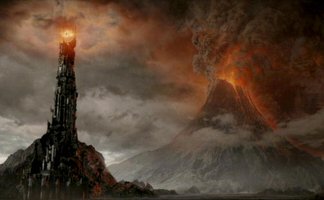 The
Siege
of Barad-dur lasted seven years. At last in 3441, Sauron himself came
down from his tower and fought with Gil-galad
and Elendil. All three fell in that mortal contest
and Isildur took the One Ring from Sauron and
kept it for himself. The Dark Tower was destroyed, but the foundations
could not be broken as long as the Ring survived.
The
Siege
of Barad-dur lasted seven years. At last in 3441, Sauron himself came
down from his tower and fought with Gil-galad
and Elendil. All three fell in that mortal contest
and Isildur took the One Ring from Sauron and
kept it for himself. The Dark Tower was destroyed, but the foundations
could not be broken as long as the Ring survived.
Sauron returned around 1050 of the Third Age and established a new stronghold at Dol Guldur in Mirkwood. The White Council attacked Dol Guldur in 2941 and the next year Sauron returned in secret to Mordor.
In 2951, Sauron declared himself openly and began rebuilding Barad-dur. Sauron had a palantir in Barad-dur; it was most likely the Ithil-stone that had been taken by the Nazgul from Minas Ithil.
Gollum was captured on the outskirts of Mordor in 3017 and he was brought to Barad-dur, where he was questioned and tortured for information about the Ring. Prisoners brought to the Dark Tower did not usually come out alive, but Sauron released Gollum on purpose hoping the creature would lead him to the Ring-bearer.
Frodo Baggins saw Barad-dur when he sat on the Seat of Seeing on Amon Hen while wearing the Ring. All hope left him when he saw the immense strength of Sauron's great fortress. Frodo felt the Eye of Sauron seeking him from the Dark Tower and just in time he managed to take off the Ring.
Grishnakh was an Orc from Barad-dur who was sent across the Anduin seeking the Ring-bearer. Another Orc named Shagrat brought Frodo's mithril shirt to Barad-dur from the Tower of Cirith Ungol on March 17, 3019. On March 25, the mithril shirt was shown to the Host of the West by the Mouth of Sauron, who was the Lieutenant of the Tower of Barad-dur.
That same day, Frodo saw Barad-dur once again as he stood on Mount Doom. The shadows around the tower were drawn aside, revealing its iron pinnacles, and in the window at the summit Frodo saw the Eye of Sauron. Sauron's attention was focused on the Battle of the Morannon at the Black Gate. When Frodo claimed the Ring, Sauron became aware of him and the Dark Tower shook from its foundations to its crown. But it was too late - the Ring was destroyed and Sam saw Barad-dur collapse in ruin.
A brief vision he had of swirling cloud, and in the midst of it towers and battlements, tall as hills, founded upon a mighty mountain-throne above immeasurable pits; great courts and dungeons, eyeless prisons sheer as cliffs, and gaping gates of steel and adamant: and then all passed. Towers fell and mountains slid; walls crumbled and melted, crashing down; vast spires of smoke and spouting steams went billowing up, up, until they toppled like an overwhelming wave, and its wild crest curled and came foaming down upon the land. And then at last over the miles between there came a rumble, rising to a deafening crash and roar; the earth shook, the plain heaved and cracked, and Orodruin reeled.
The Return of the King: "Mount Doom," p. 224
Names
& Etymology:
The Dark Tower was called
Barad-dûr
in Sindarin and Lugbúrz in Black Speech. Barad-dûr
means "Dark Tower" from barad meaning "tower" and dûr
meaning "dark." The name Lugbúrz also means "Dark Tower"
in the Black Speech from lug meaning "tower" and búrz
meaning "dark."
Sources:
The Fellowship
of the Ring: "The Shadow of the Past," p. 53, 60; "Many Meetings,"
p. 238; "The Council of Elrond," p. 257, 264; "The Ring Goes South," p.
289; "A Journey in the Dark," p. 309; "The Mirror of Galadriel," p. 371;
"The Breaking of the Fellowship," p. 409
The Two
Towers: "The Departure of Boromir," p. 18; "The Riders of Rohan," p.
39; "The Uruk-hai," p. 49, 55, 58; "The White Rider," p. 99, 100; "The
Road to Isengard," p. 161; "Flotsam and Jetsam," p. 169; "The Voice of
Saruman," p. 188; "The Palantir," p. 194, 199, 203-204; "The Taming of
Smeagol," p. 210; "The Passage of the Marshes," p. 242; "The Black Gate
Is Closed," p. 245, 251-52; "Of Herbs and Stewed Rabbit," p. 265, 268;
"Shelob's Lair," p. 332; "The Choices of Master Samwise," p. 346, 348-50
The Return
of the King: "The Siege of Gondor," p. 92; "The Last Debate," p. 155,
156; "The Black Gate Opens," p. 164; "The Tower of Cirith Ungol," p. 175-77,
178; "The Land of Shadow," p. 196, 200, 209; "Mount Doom," p. 212, 214,
215, 219-20, 223-24; "The Steward and the King," p. 241; "The Scouring
of the Shire," p. 284
Appendix
A of The Lord of the Rings: "The Numenorean Kings," p. 317
Appendix
B of The Lord of the Rings: "The Tale of Years," p. 364-66, 370, 375
The Silmarillion:
"Akallabeth,"
p. 267, 270, 280; "Of the Rings of Power and the Third Age," p. 292, 294,
302, 304; "Appendix - Elements in Quenya and Sindarin Names," entries for
barad
and dur
Unfinished
Tales: "The Hunt for the Ring," p. 337; "The Druedain," p. 387 note
11
Map of
Gondor and Mordor by Christopher Tolkien
Ardalambion
- Black Speech
Barad Eithel |
Map
showing Barad Eithel
|
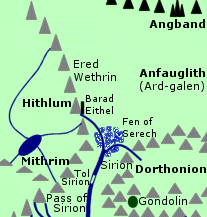 Fortress
at the source of the Sirion. Barad Eithel was located on the eastern face
of the Ered Wethrin above Eithel Sirion, the spring where the Great River
arose. The fortress overlooked Ard-galen,
the plain that stretched to the gates of Morgoth's stronghold Angband.
Fortress
at the source of the Sirion. Barad Eithel was located on the eastern face
of the Ered Wethrin above Eithel Sirion, the spring where the Great River
arose. The fortress overlooked Ard-galen,
the plain that stretched to the gates of Morgoth's stronghold Angband.
Barad Eithel guarded a pass over the Ered Wethrin into Hithlum, the realm of Fingolfin, the High King of the Noldor. There were several mountain fortresses along the eastern border, but Barad Eithel was Fingolfin's primary stronghold. Cavalry based at Barad Eithel patrolled the plains of Ard-galen.
During the Battle of Sudden Flame in 455 of the First Age, rivers of fire from Angband turned the grassy plain of Ard-galen into the desert of Anfauglith. The Elves of Hithlum and their allies the Men of Dor-lomin were driven back to the mountain forts.
Morgoth's forces were unable to breach the line of defense into Hithlum, but Hador, the Lord of Dor-lomin, was slain before the walls of Barad Eithel along with his younger son Gundor. Fingolfin rode to Angband after the battle and was killed in single combat with Morgoth. His son Fingon became High King of the Noldor.
Morgoth sent another army against Hithlum in 462 and Barad Eithel was besieged. Hador's son Galdor was killed by an arrow. His son Hurin drove the enemy forces back from Barad Eithel and purused them across Anfauglith.
In 472, Fingon waited on the walls of Barad Eithel for a signal from Maedhros to launch a two-pronged attack against Angband. But Maedhros was delayed, and Morgoth sent an army in camouflage across Anfauglith to Barad Eithel. When Fingon did not respond to their approach, the enemy captain brought out a prisoner named Gelmir of Nargothrond and had him killed in plain view of the defenders of Barad Eithel.
Gelmir's brother Gwindor was on the outworks of Barad Eithel, and in his anger he launched a premature attack against Morgoth's forces. Fingon ordered his troops to follow and advance on Angband, but despite their initial success they were ultimately defeated in the Battle of Unnumbered Tears. Fingon was killed and no Elves returned to Hithlum, which Morgoth gave to the Easterlings.
Names &
Etymology:
The name Barad Eithel means
"Tower of the Well" in Sindarin from barad meaning "tower" and eithel
meaning "well, spring."
Sources:
The Silmarillion:
"Of the Return of the Noldor," p. 107; "Of Beleriand and Its Realms," p.
119-20; "Of the Ruin of Beleriand," p. 152, 160; "Of the Fifth Battle,"
p. 190-91; "Appendix - Elements in Quenya and Sindarin Names," entries
for barad and eithel
Unfinished
Tales: "Narn I Hin Hurin," p. 60, 65, 75
The History
of Middle-earth, vol. XI, The War of the Jewels: "The Grey Annals,"
p. 38, 52-53, 60, 165, 168
Barad Nimras |
Map
showing Barad Nimras
|
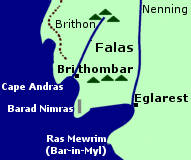 Watchtower
on the west coast of Beleriand in Middle-earth. Barad Nimras was located
in the coastal region of the Falas. The tower stood on a headland between
the mouths of the Brithon and the Nenning.
The havens of Brithombar and Eglarest
were at the mouths of the Brithon and the Nenning respectively.
Watchtower
on the west coast of Beleriand in Middle-earth. Barad Nimras was located
in the coastal region of the Falas. The tower stood on a headland between
the mouths of the Brithon and the Nenning.
The havens of Brithombar and Eglarest
were at the mouths of the Brithon and the Nenning respectively.
Barad Nimras was built in the year 65 of the First Age by Finrod Felagund, who ruled the Realm of Nargothrond east of the Falas. The tower was used to watch for enemy ships, but Morgoth never waged war from the Sea.
In 473, Morgoth's forces attacked Brithombar and Eglarest by land from the north. The havens were destroyed and Barad Nimras was cast down.
Names &
Etymology:
The name Barad Nimras means
"white horn tower" in Sindarin from barad meaning "tower," nim
meaning "white," and ras meaning "horn."
Sources:
The Silmarillion:
"Of Beleriand and Its Realms," p. 120; "Of the Fifth Battle," p. 196; "Appendix
- Elements in Quenya and Sindarin Names," entries for barad, nim, ras
The History
of Middle-earth, vol. XI, The War of the Jewels: "The Grey Annals,"
p. 40, 80, 118; "The Later Quenta Silmarillion," p. 184 (map), 190, 196-98
Names &
Etymology:
The name Calmindon means
"Light-tower" in Quenya from cal or kal meaning "shine" and
mindon
meaning "tower."
Sources:
Unfinished
Tales: "Aldarion and Erendis," p. 182
The Silmarillion:
"Appendix - Elements in Quenya and Sindarin Names," entries for kal
and minas
After being held captive in a barrow by the Barrow-wight, Merry Brandybuck had the memory of a man who had fought against the Men of Carn Dum.
Names &
Etymology:
Carn Dûm means "red
valley" from carn meaning "red" and dûm derived from
tûm
meaning "deep valley."
Sources:
The Fellowship
of the Ring: "Fog on the Barrow-downs," p. 154, 157
Appendix
A of The Lord of the Rings: "The North-kingdom and the Dunedain," p.
331
The History
of Middle-earth, vol. V, The Lost Road and Other Writings: "The Etymologies,"
entries for KARAN and TUB
The History
of Middle-earth, vol. VI, The Return of the Shadow: "The Ring Goes
South," p. 433 note 13 (meaning of Carn Dum)
On March 11, 3019 of the Third Age, Faramir led a force to defend the river crossing at Osgiliath from an approaching army led by the Witch-king of Angmar. Faramir's men were outnumbered ten to one. The enemy forces crossed the Anduin on March 12 and Faramir retreated to the Causeway Forts but could not hold them.
On March 13, the Causeway Forts were wrecked and many of Faramir's men were killed. Faramir himself was gravely injured in the retreat across the Pelennor Fields. The Witch-king's forces breached the Rammas Echor and besieged Minas Tirith.
Names &
Etymology:
Also called the Guard-towers.
Sources:
The Return
of the King: "Minas Tirith," p. 22; "The Siege of Gondor," p. 81, 91-92
The Citadel |
Layout
of the major buildings in the Citadel
|
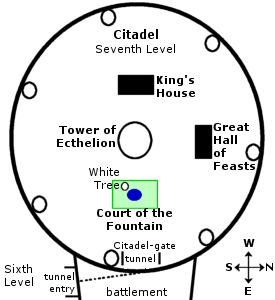 Fortress
on the seventh level of Minas Tirith. The
Citadel was at the summit of the Hill of Guard,
700 feet above ground. It was encircled by a wall and seven towers. There
was a battlement on the east side atop a stone spur that overlooked the
Pelennor
Fields.
Fortress
on the seventh level of Minas Tirith. The
Citadel was at the summit of the Hill of Guard,
700 feet above ground. It was encircled by a wall and seven towers. There
was a battlement on the east side atop a stone spur that overlooked the
Pelennor
Fields.
The Citadel could be reached from the sixth level by a tunnel sloping upwards through the spur to the Citadel-gate. Inside the gate was the Court of the Fountain. The courtyard was paved with white stones. A fountain stood in a grassy area and beside it was the White Tree of Gondor.
The Tower of Ecthelion stood in the center of the Citadel. The tower was 300 feet high and a standard flew from its pinnacle. At its base was the Tower Hall - also called the Hall of the Kings - where the rulers of Gondor conducted affairs of state. The palantir called the Anor-stone was kept in a secret room at the top of the tower.
The rulers lived in the King's House behind the Tower of Ecthelion. The Great Hall of Feasts was located north of the Tower. There were a number of other buildings and houses on streets around the edge of the Citadel, including the lodgings on the north side where Pippin and Gandalf stayed.
The Guards of the Citadel were an elite unit. They were the last line of defense of Minas Tirith and they were not allowed to leave the Citadel without their lord's permission. They wore tall helmets of mithril with white wings on each side. Their livery was black emblazoned with the emblems of Elendil - a White Tree under a silver crown and stars. Pippin Took became a Guard of the Citadel during the War of the Ring.
Minas Tirith was originally Minas Anor, built by Elendil's son Anarion at the end of the Second Age. Anarion was killed in the War of the Last Alliance, and his brother Isildur planted the White Tree in the Citadel in his memory. The White Tree died during the Great Plague of 1636 of the Third Age but a seedling was replanted in the Citadel in 1640 by King Tarondor.
The Tower in the Citadel was not built until 1900 during the reign of King Calimehtar. It was repaired and rebuilt in 2698 by Ecthelion I, the Steward of Gondor, after whom the tower was named.
The White Tree died in 2872 but this time there was no seedling to replace it so the Dead Tree was left standing. After the War of the Ring, Aragorn, King Elessar, found a seedling on Mount Mindolluin and planted it in the Citadel where it flourished and was seen as a sign of the rebirth of the Kingdom of Gondor.
Names &
Etymology:
The Citadel was also called
the High City.
Sources:
The Return
of the King: "Minas Tirith," p. 23-26, 31-36, 39-40, 44; "The Siege
of Gondor," p. 80, 87, 94-95, 99-100; "The Pyre of Denethor," p. 126-27,
131; "The Houses of Healing," p. 137-38; "The Steward and the King," p.
244, 246, 250-51; "Many Partings," p. 252-53
Appendix
A of The Lord of the Rings: "Gondor and the Heirs of Anarion," p. 328;
"The Stewards," p. 334
Appendix B
of The Lord of the Rings: "The Tale of Years," p. 366--67, 369
The Silmarillion:
"Of the Rings of Power and the Third Age," p. 294
The History
of Middle-earth, vol. IX, Sauron Defeated: "Many Partings," p. 67
The Lord
of the Rings: A Reader's Companion by Wayne G. Hammond and Christina
Scull: "The Steward and the King," p. 638
Dol Guldur |
Dol
Guldur by Rob Alexander
|
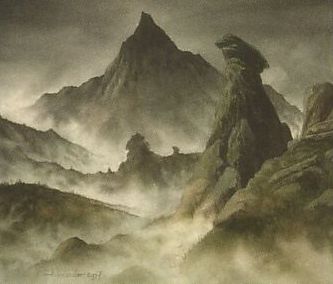 Hill
and stronghold of Sauron in Mirkwood.
The hill of Dol Guldur was originally called Amon Lanc, the Naked Hill,
because it was bare of trees with a stony summit. Amon Lanc was on the
western edge of the forest across the Anduin
from Lothlorien. It was the highest point
in the southwestern part of the forest. King Oropher
of the Woodland Realm and his people originally lived around Amon Lanc
but they gradually moved northward.
Hill
and stronghold of Sauron in Mirkwood.
The hill of Dol Guldur was originally called Amon Lanc, the Naked Hill,
because it was bare of trees with a stony summit. Amon Lanc was on the
western edge of the forest across the Anduin
from Lothlorien. It was the highest point
in the southwestern part of the forest. King Oropher
of the Woodland Realm and his people originally lived around Amon Lanc
but they gradually moved northward.
Around the year 1050 of the Third Age, Sauron began to regain strength after his defeat in the War of the Last Alliance. He came to Amon Lanc and built a great tower and stronghold on the hill. The hill was renamed Dol Guldur, the Hill of Black Magic, and the stronghold was referred to by this name as well. A shadow fell over the forest and it came to be called Mirkwood. The gloom was especially heavy around Dol Guldur and Great Spiders came to dwell around the hill.
The evil power that occupied Dol Guldur was known as the Necromancer. It was not known at first that the Necromancer was Sauron; it was thought that it might be one of the Nazgul. But as the power grew in strength, Gandalf became suspicious and he went to Dol Guldur to investigate in 2063. Sauron fled and went into hiding for a while. The Watchful Peace lasted until 2460, when Sauron returned to Dol Guldur.
In 2845, Thrain was captured and thrown into the dungeons of Dol Guldur. Thrain had the last of the Seven Rings of the Dwarves, and Sauron tormented him and took it from him. Gandalf came to Dol Guldur in disguise in 2850 and found Thrain near death. Before he died, Thrain gave Gandalf a map and key to the Lonely Mountain to be passed on to his son Thorin Oakenshield.
Gandalf explored the secrets of Dol Guldur and discovered that the evil presence was in fact Sauron. At a meeting of the White Council in 2851 he urged an attack on the stronghold. Saruman overruled him, saying that Sauron could not regain his full strength without the One Ring. Saruman claimed that the Ring had most likely been washed down the Anduin to the Sea, but in fact he believed it lay hidden in the Gladden Fields where Isildur had perished. Saruman coveted the Ring and he hoped that it might reveal itself by seeking its master if Sauron remained in nearby Dol Guldur.
Gandalf remained troubled by Sauron's presence, and at a White Council meeting in 2941 he once again proposed that they attack Dol Guldur. This time Saruman agreed because he had learned that Sauron was also searching for the One Ring in the Gladden Fields. The Council put forth their full strength and drove Sauron from Dol Guldur with the help of the devices that Saruman had developed during his study of the Enemy. But Sauron had been prepared for the assault and he went in secret to the Dark Tower, his great stronghold in Mordor.
Sauron maintained an outpost at Dol Guldur and in 2951 he sent the Nazgul known as Khamul the Easterling to command the stronghold. Khamul was accompanied by one or two of the other Nazgul. A number of Orcs were stationed there as well.
In March of 3018, scouts from Dol Guldur became aware that Gollum had been brought to Mirkwood and was being held prisoner by Thranduil. On June 20, Orcs from Dol Guldur attacked the Elves who were guarding Gollum. Gollum escaped from the Elves, but he also managed to elude capture by the Orcs.
During the War of the Ring, forces from Dol Guldur attacked Lothlorien three times. The first assault on March 11 was repelled by the Elves and the power of Galadriel. Hosts of the Orcs then turned south and entered the Wold of Rohan where they were confronted by Treebeard and the Ents on March 12. Most of these Orcs were slain or driven into the Anduin. On March 15, the second assault was launched against Lothlorien, while farther north in Mirkwood forces from Dol Guldur engaged the Elves of the Woodland Realm in battle. Both attacks were thwarted by the Elves. The third assault on Lothorien took place on March 22, but it too failed.
After the defeat of Sauron on March 25, Celeborn led a force from Lothlorien across the Anduin on March 28. The Elves captured Dol Guldur and Galadriel threw down the walls of the stronghold and the shadow was lifted from the forest.
Names &
Etymology:
Dol Guldur means "Hill of
Black Magic." The word dol means "head" and is often used in the
names of hills and mountains. The word guldur means "black magic."
The element gûl means "sorcery, magic" from the stem ngol
or nólë meaning "long study, lore, knowledge." The element
dûr
means
"dark."
Dol Guldur was originally called Amon Lanc. Amon Lanc means "Naked Hill" from amon meaning "hill" and lanc meaning "naked."
Sources:
The Hobbit:
"An Unexpected Party," p. 34; "Queer Lodgings," p. 149; "The Last Stage,"
p. 310
The Fellowship
of the Ring: "The Council of Elrond," p. 263, 269, 270, 282; "A Journey
in the Dark," p. 309; "Lothlorien," p. 366
The Two
Towers: "The Black Gate Is Closed," p. 252; "Shelob's Lair," p. 332
The Return
of the King: "The Muster of Rohan," p. 78; "Many Partings," p. 257
Appendix
B of The Lord of the Rings: "The Tale of Years," p. 366, 368-70,
374-75
Unfinished
Tales: "The History of Galadriel and Celeborn," p. 236, 244, 246, 252;
"The Disaster of the Gladden Fields," p. 280 notes 12 and 14; "Cirion and
Eorl," p. 297-98, 303, 307, 313 note 19; "The Quest of Erebor," p. 321-24,
330, 332, 336; "The Hunt for the Ring," p. 338-39, 343-45, 350, 352-53
note 1
The Silmarillion:
"Appendix - Elements in Quenya and Sindarin Names," entries for dol
and gul
The Stone of Osgiliath was kept in the Dome of Stars. This was the chief of the palantiri in Middle-earth. It was very large and it was kept on a low, round, black marble table with a depression in the middle to hold the palantir.
The Dome of Stars was built after Gondor was founded in the year 3320 of the Second Age. During the civil war of the Kin-strife in 1437 of the Third Age, Osgiliath was captured by the rebel leader Castamir. The Dome of Stars was destroyed and the Stone of Osgiliath was lost in the waters of the Anduin.
Names &
Etymology:
The Dome of Stars was also
referred to as the Tower of the Dome of Osgiliath. In some editions
of The Lord of the Rings this was printed
as the Tower of the Stone of Osgiliath, but Tolkien later corrected
it to Tower of the Dome of Osgiliath.
The name Dome of Stars is related to the name Osgiliath which means "Citadel of the Stars." It is possible that one could see and observe the stars of the night sky in the Dome of Stars.
Sources:
The Two
Towers: "The Palantir," p. 203
Appendix
A of The Lord of the Rings: "Gondor and the Heirs of Anarion," p. 327
Unfinished
Tales: "The Palantiri," p. 408-9
The Lord
of the Rings: A Reader's Companion by Wayne G. Hammond and Christina
Scull: "The Palantir," p. 437; "Appendix A," p. 694
Dunharrow |
Dunharrow
by Alan Lee
|
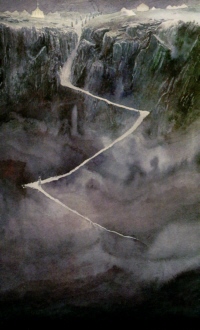 Mountain
refuge in Rohan; site of the door to the Paths
of the Dead. Dunharrow was located in the valley of Harrowdale
in the White Mountains. It was on the
eastern side of the valley, several hundred feet above the ground.
Mountain
refuge in Rohan; site of the door to the Paths
of the Dead. Dunharrow was located in the valley of Harrowdale
in the White Mountains. It was on the
eastern side of the valley, several hundred feet above the ground.
Dunharrow was formed by the juncture of three mountains: Irensaga to the north, the Starkhorn to the south, and the Dwimorberg in the center. It was a high, level space covered by a grassy field called the Firienfeld. A road lined on each side by uncarved standing stones led through the Firienfeld to the Dwimorberg. There, in a small wood named the Dimholt, was the Dark Door leading into the Paths of the Dead.
From the valley floor, Dunharrow could only be reached by way of the Stair of the Hold - a switchback path that zigzagged up a sheer cliff. This made the refuge defensible against an enemy attack. At each turn of the path there was a stone figure shaped like a man. These statues were known as Pukel-men.
The Pukel-men resembled the Druedain, a race of Men who lived in the White Mountains in the First Age. The Druedain were known for carving stone images of themselves called watch-stones, which they placed at the turnings of paths. It seems likely that the Pukel-men at Dunharrrow were made by them.
The Druedain were driven out of the White Mountains by a group of wicked Men from the East who became known as the Men of the Mountains. Dunharrow became a sacred place for the Men of the Mountains. At the end of the Second Age, these Men were cursed by Isildur for breaking their oath to fight Sauron. They fled behind the Dark Door and haunted the Paths of the Dead. The were called the Dead Men of Dunharrow.
In the Third Age, Dunharrow was discovered by the Rohirrim during the reign of Rohan's second King, Brego (2545-2570). Brego and his son Baldor found it while exploring the valley of Harrowdale for places where their people could seek refuge in time of need. At the entrance to the Paths of the Dead, they encountered an old man who told them that the door was not open to the living. Baldor later entered the Dark Door and never returned.
When Rohan was invaded by Dunlendings in 2758, a group of Rohirrim led by Frealaf retreated to Dunharrow and took refuge there during the Long Winter. In the spring of 2759, Frealaf led a raid against the Dunlendings and recaptured Edoras from them.
During the War of the Ring, Dunharrow was once again used as a refuge by the Rohirrim. Eowyn, the niece of King Theoden, led many of the people of Edoras there and organized their lodgings and provisions. King Theoden came to Dunharrow on March 9, 3019, and oversaw the muster of his army in Harrowdale the next day. When the army set out for Minas Tirith, many women, children, and old men remained behind in Dunharrow until Sauron was defeated.
Names &
Etymology:
Dunharrow is derived from
the word Dunhaerg or Dunharg, meaning "the heathen fane on
the hillside" in the language of Rohan and in Old English, from the word
dun
meaning "hill" and the word hearg meaning "temple, sanctuary." A
fane
is a temple or sacred place. Dunharrow was so named because it was once
a sacred site of the Men of the Mountains.
Also called the Hold of Dunharrow or simply the Hold.
Sources:
The Two
Towers: "The King of the Golden Hall," p. 123, 128; "Helm's Deep,"
p. 144; "The Palantir," p. 194
The Return
of the King: "The Passing of the Grey Company," 50, 52, 56-60; "The
Muster of Rohan," passim; "The Ride of the Rohirrim," p. 106
Appendix
A of The Lord of the Rings: "The House of Eorl," p. 348
Appendix
E of The Lord of the Rings: "Writing and Spelling," p. 395
Unfinished
Tales: "The Druadan," p. 379, 383-84
"Nomenclature
of The Lord of the Rings," entry for Dunharrow
Durin's Tower |
Durin's
Tower by Jeremy Bennett
Artwork from the New Line film |
| Tower upon
the
Silvertine. Durin's Tower was
built by the Dwarves in ancient times on the peak of the Silvertine, which
they called Zirak-zigil - one of the three Mountains of Moria under which
lay the realm of Khazad-dum. The tower was carved
out of the living rock of the mountain and stood upon a high eyrie. The
Endless
Stair led to the tower from the foundations of the mountain.
By the end of the Third Age, Durin's Tower had long been lost. Some Dwarves believed it had been destroyed, while others thought it was only a legend. On January 23, 3019 of the Third Age, Gandalf and the Balrog climbed the Endless Stair to Durin's Tower. Upon the Silvertine they fought the Battle of the Peak from January 23 to 25. During the battle, the tower was destroyed and the entrance to the stair was blocked. Source:
|
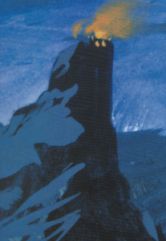 |
DurthangFortress in Mordor. Durthang overlooked the valley of Udun which lay behind the Black Gate. It was on the southwestern side of the valley, high in the Mountains of Shadow, at the point where the main range branched toward the Black Gate.Durthang was originally a stronghold of Gondor, built to keep watch on Mordor after Sauron's defeat in the War of the Last Alliance at the end of the Second Age. But as Gondor’s power declined, their watch on Mordor became lax and Durthang was eventually abandoned. As Mordor became repopulated with Sauron’s servants, Durthang became an Orc stronghold. On March 18, 3019 of the Third Age, Frodo Baggins and Sam Gamgee were on the road leading eastward from Durthang when a troop of Orcs from Durthang caught up with them. The Hobbits were disguised as Orcs and they were forced to march along with the troop for some distance before they were able to slip away. Names &
Etymology:
Sources:
|
Map
of Durthang
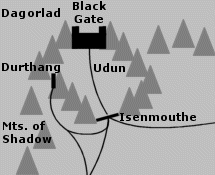 |
Elostirion & the White Towers |
Elostirion
and the White Towers
by Ted Nasmith |
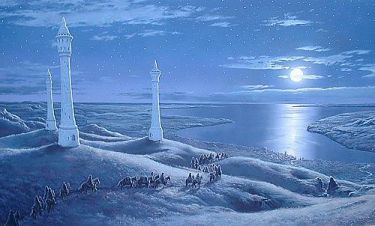 Towers
in the Tower Hills west of the
Shire. Elostirion was the tallest of the three White Towers that were
built by Gil-galad for Elendil.
Towers
in the Tower Hills west of the
Shire. Elostirion was the tallest of the three White Towers that were
built by Gil-galad for Elendil.
The palantir called the Elendil Stone was kept at Elostirion. This palantir was not in accord with the others and looked west across the Sea to Eressea, where the Master-stone was kept in the Tower of Avallone. Elostirion and the Elendil Stone were long guarded by Cirdan and the Elves of the Grey Havens, and when Elrond left Middle-earth in 3021 of the Third Age, Cirdan placed the palantir on his ship.
Hobbits said that one could see the Sea from the top of Elostirion, but no Hobbit had ever been known to climb it. At Crickhollow, Frodo dreamed of Elostirion in one of many dreams he had about the Sea:
Then he heard a noise in the distance. At first he thought it was a great wind coming over the leaves of the forest. Then he knew that it was not leaves, but the sound of the Sea far-off; a sound he had never heard in waking life, though it had often troubled his dreams. Suddenly he found he was out in the open. There were no trees after all. He was on a dark heath, and there was a strange salt smell in the air. Looking up he saw before him a tall white tower, standing alone on a high ridge. A great desire came over him to climb the tower and see the Sea. He started to struggle up the ridge towards the tower: but suddenly a light came in the sky, and there was a noise of thunder.In the year 34 of the Fourth Age, Samwise Gamgee's daughter Elanor and her husband Fastred of Greenholm moved to Undertowers in the Tower Hills. Their descendants came to be called the Fairbairns of the Towers.
The Fellowship of the Ring: "A Conspiracy Unmasked," p. 119
Names &
Etymology:
The name Elostirion is composed
of el meaning "star," ost meaning "fortress," and tirion
meaning "great watch tower."
Sources:
The Fellowship
of the Ring: "Prologue: Concerning Hobbits," p. 16
Appendix
A of The Lord of the Rings: "The North-kingdom and the Dunedain," p.
322 (footnote 2)
Appendix
B of The Lord of the Rings: "The Tale of Years," p. 378
The Silmarillion:
"Of the Rings of Power and the Third Age," p. 292; Index entry for Tirion;
"Appendix - Elements in Quenya and Sindarin Names," entries for el and
ost
Unfinished
Tales: "The Palantiri," p. 413-14 (footnote 16)
Helm's Deep & The Hornburg |
Top:
Helm's Deep in the New Line film,
art by Jeremy Bennett
Bottom: Helm's Deep by J.R.R. Tolkien |
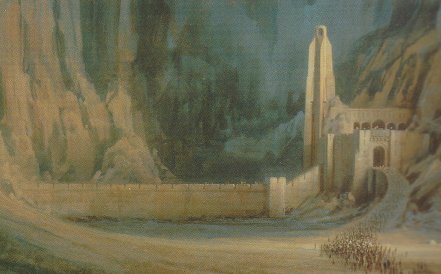 Stronghold
in Rohan; site of the Battle
of Helm's Deep - one of the key battles of the War
of the Ring.
Stronghold
in Rohan; site of the Battle
of Helm's Deep - one of the key battles of the War
of the Ring.
Helm's Deep was located near the Gap of Rohan at the foot of the three-peaked mountain called the Thrihyrne in the northwestern fork of the White Mountains. Between the arms of the Thrihyrne lay a valley called the Deeping-coomb. A trench and rampart called Helm's Dike stretched across the Deeping-coomb. Two furlongs - or a quarter mile - behind Helm's Dike was Helm's Gate, the entrance to Helm's Deep.
Helm's Deep was a narrow ravine with high cliffs on the northern and southern sides that blocked out the sunlight. The Deeping-wall was built across the entrance to the ravine, and at the northern end of the wall was the fortress of the Hornburg. No enemy had ever captured the Hornburg while it was defended.
The Hornburg stood on a spur called the Hornrock that jutted out from the northern cliff. The Hornburg was surrounded by a wall, behind which was an outer court and a citadel containing an inner court and a tall tower. In the tower was the great horn of Helm Hammerhand. When the horn was sounded, it echoed throughout the ravine and caused fear and dismay among enemy forces.
A causeway led up to the Hornburg-gates. To one side of the main gate a narrow walkway led along the edge of the Hornrock to a small postern-door into the Hornburg. There was also a rear-gate with a stairway leading down from the Hornburg into the ravine behind the Deeping-wall.
The Deeping-wall stood 20 feet high and was wide enough for four men to stand side by side. The surface of the wall was smooth and nearly seamless. There was a tall parapet on the wall with openings for archers. Three staircases led down from the back of the wall into the ravine, and another staircase led up into the Hornburg.
Behind the Deeping-wall, the cliffs drew closer together and formed the Narrows. At the far end of the Narrows was the entrance to the Glittering Caves under the Thrihyrne. The Deeping-stream flowed from the caves and passed under the Deeping-wall through a small culvert and then looped around the Hornburg and under the causeway. From the Hornburg, the Deeping-road ran alongside the Deeping-stream to the Great West Road.
The fortress and the Deeping-wall were built in the Third Age by the Men of Gondor sometime during the reign of the Ship-kings (830-1149). Its purpose was to guard the southern side of the Gap, while Isengard guarded the northern side.
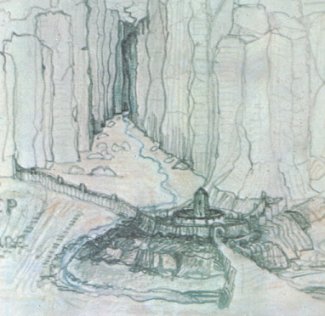 In
2510, the stronghold became part of the new land of Rohan. When Rohan was
invaded by Men from Dunland in 2758, King
Helm led his people to take shelter there. The ravine became known as Helm's
Deep, and the fortress was called the Hornburg because Helm would sound
his great horn before coming forth from the stronghold to raid the enemy
camps.
In
2510, the stronghold became part of the new land of Rohan. When Rohan was
invaded by Men from Dunland in 2758, King
Helm led his people to take shelter there. The ravine became known as Helm's
Deep, and the fortress was called the Hornburg because Helm would sound
his great horn before coming forth from the stronghold to raid the enemy
camps.
Helm and his people were besieged in Helm's Deep during the Long Winter of November 2758 to March 2759. After Yule, supplies ran low and the people in Helm's Deep were starving. Helm's son Hama left to find food but never returned. Helm later froze to death standing on Helm's Dike. The invaders were finally driven out of Rohan by Helm's nephew Frealaf.
At the time of the War of the Ring,King Theoden's son Theodred had his base at Helm's Deep, and Erkenbrand, the lord of the Westfold, dwelled there as well. After Theodred was killed in the First Battle of the Fords of Isen on Feburary 25, 3019, Erkenbrand realized that Saruman was planning to invade Rohan. He made necessary repairs and strengthened the defenses of Helm's Deep. Many of the people of the Westfold took shelter in the Glittering Caves. Erkenbrand rode out to gather the forces of the Westfold, leaving about 1,000 Rohirrim to defend Helm's Deep, including a company led by Gamling to man Helm's Dike.
King Theoden arrived at Helm's Deep with a force of more than 1,000 Rohirrim from Edoras on the evening of March 3. Theoden entered the Hornburg while his nephew Eomer commanded the defenses on the Deeping-wall with the help of Aragorn. Saruman's army of 10,000 Orcs as well as Men of Dunland began the assault on Helm's Deep after midnight on March 4.
Eomer and Aragorn led a sortie from the postern-door to prevent the enemy forces from battering down the gates and entering the Hornburg. But Orcs set off an explosive device in the culvert under the Deeping-wall and they entered Helm's Deep through the breach. Many of the Rohirrim retreated into the Hornburg, while others who were cut off went farther back into Helm's Deep to defend the entrance to the Glittering Caves where the refugees hid.
At dawn, the Orcs blew up the main gate of the Hornburg, but at that moment the horn of Helm Hammerhand sounded and Theoden led a charge from the gate down the causeway and all the way to Helm's Dike. Saruman's forces fled before them, and in the Deeping-coomb beyond Helm's Dike they were confronted by a forest of Huorns sent by Treebeard that had filled the valley during the night. On the western ridge of the valley, Erkenbrand arrived with Gandalf and 1,000 Rohirrim and charged down the slopes. The Men of Saruman's army surrendered, and the Orcs fled among the Huorns and never emerged again.
The day after the Battle of Helm's Deep, the dead of Rohan were buried in two mounds in the field in front of the Hornburg, while Hama, the captain of the King's guard, was buried in a solitary grave. In the middle of the next night, the Huorns buried the Orcs under a hill of stones that became known as the Death Down where no man dared to walk.
Names &
Etymology:
Helm's Deep was named for
Helm Hammerhand, who took refuge there. The word deep refers to
the deep valley between the cliffs.
The Hornburg was named for the great horn of Helm. The word burg means "fortress, castle" in Old English. The Hornburg was also sometimes simply called the Burg and the Hornrock was called the Rock.
Before the time of Helm Hammerhand, the Rohirrim called the Hornburg the Súthburg. The name Súthburg means "southern fortress," because it guarded the southern side of the Gap of Rohan.
The Men of Gondor originally gave the same name to the stronghold and the caves behind it - Aglarond, meaning "glittering caves."
Sources:
The Two
Towers: "Helm's Deep," passim; "The Road to Isengard," p. 148-53, 158
The Return
of the King: "The Passing of the Grey Company," p. 48-56
Appendix
A of The Lord of the Rings: "The House of Eorl," p. 347-48
Unfinished
Tales: "The Battles of the Fords of Isen," p. 356, 358-60, 362-63,
365 note 6, 367, 370-71, 373
Pictures
by J.R.R. Tolkien: #26 - "Helm's Deep and the Hornburg"
Old English
Minas Ithil / Minas Morgul |
Frodo
and Sam approach Minas Morgul
in the New Line film |
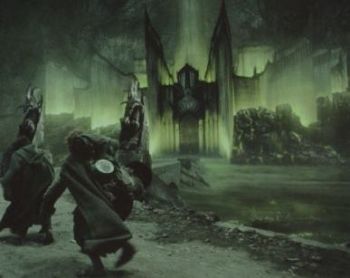 Minas
Morgul was the stronghold of the Nazgul. It was
located in the Morgul Vale, a valley
in the Mountains of Shadow on the
western border of
Mordor. It was a walled city
of white marble built on a high shelf of rock. Within the walls there were
white houses and a tall tower. The walls and the tower had many windows,
and the top of the tower revolved slowly back and forth.
Minas
Morgul was the stronghold of the Nazgul. It was
located in the Morgul Vale, a valley
in the Mountains of Shadow on the
western border of
Mordor. It was a walled city
of white marble built on a high shelf of rock. Within the walls there were
white houses and a tall tower. The walls and the tower had many windows,
and the top of the tower revolved slowly back and forth.
The Morgul-road ran from Osgiliath on the Anduin through Ithilien to the Morgul Vale and crossed the Mountains of Shadow into Mordor. Near the main gate of Minas Morgul in the city's northern wall, the road spanned a white bridge over the Morgulduin. At the head of the bridge stood hideous carved figures of both human and animal form.
Minas Morgul was originally called Minas Ithil, the Tower of the Moon. It was built to keep watch on Mordor when Gondor was founded in 3320 of the Second Age. Isildur, son of Elendil, made his home in Minas Ithil, while Isildur's brother Anarion dwelled across the Anduin in Minas Anor. Minas Ithil was a beautiful city and its walls gleamed silver and white with moonlight. In front of his house, Isildur planted a sapling of the White Tree which he had rescued from the Downfall of Numenor, and in the tower was kept one of the palantiri called the Ithil-stone.
It was believed that Sauron had perished in the Downfall of Numenor, but his spirit surivived and he returned to Mordor in the same year that Gondor was founded. With the One Ring, he secretly rebuilt his power. In 3429 of the Second Age, Sauron seized Minas Ithil and burned the White Tree, but Isildur escaped with a seedling of the Tree.
After Sauron was defeated in the War of the Last Alliance in 3441, a watch was kept from Minas Ithil. But in 1636 of the Third Age, the Great Plague came from the east and killed many in Gondor. The guard on Mordor began to relax and people left Minas Ithil.
The Nazgul returned to Mordor in 1980 to prepare for Sauron's return. The Nazgul were the servants of Sauron who had taken the Nine Rings of Men from him long ago. Their leader was the Witch-king of Angmar, Lord of the Nazgul. In 2000 they laid siege to Minas Ithil and they captured the city in 2002 and took possession of the Ithil-stone. Minas Ithil became the stronghold of the Nazgul and it was renamed Minas Morgul, the Tower of Black Sorcery. It was a place of fear and dread and its walls held a sickly light.
Not the imprisoned moonlight welling through the marble walls of Minas Ithil long ago, Tower of the Moon, fair and radiant in the hollow of the hills. Paler indeed than the moon ailing in some slow eclipse was the light of it now, wavering and blowing like a noisome exhalation of decay, a corpse-light, a light that illuminated nothing.Across the Anduin, Minas Anor was renamed Minas Tirith, the Tower of Guard, and the Men of Gondor were vigilant against the threat from Minas Morgul.
The Two Towers: "The Stairs of Cirith Ungol," p. 312
In 2050, King Earnur of Gondor accepted a challenge to fight the Witch-king of Angmar in single combat. He rode with a small company of knights to Minas Morgul and they were never seen again. Earnur was believed to have died in torment in Minas Morgul. He left no heir, and it was from that time that the Stewards began to rule Gondor in absence of a King.
Sauron returned secretly to Mordor in 2942 and in 2951 he declared himself openly and began to gather power again. Sauron claimed the Ithil-stone and with it he was later able to ensnare Saruman and deceive Denethor, Steward of Gondor, who each had one of the other palantiri.
At the time of the War of the Ring, the Witch-king of Angmar and most of the Nazgul dwelled in Minas Morgul; two or three other Nazgul occupied Dol Guldur in Mirkwood. Numerous Orcs, including Gorbag, were also stationed in Minas Morgul and the Silent Watchers were ever-vigilant.
On June 20, 3018, the Witch-king rode forth to lead an assault on Osgiliath, and then he rode north with the Nazgul in search of the Hobbit who bore the One Ring.
Frodo Baggins, the Ring-bearer, passed Minas Morgul on the way into Mordor with Sam Gamgee and their guide Gollum on March 10, 3019. Frodo felt compelled by the power of the Ring to approach the city where the Witch-king dwelled, but he was stopped by Sam and Gollum at the head of the bridge. They had begun to climb the path leading to Cirith Ungol when a great red flash was sent up from Barad-dur as a signal to launch the assault on Gondor.
And Minas Morgul answered. There was a flare of livid lightnings: forks of blue flame springing up from the tower and from the encircling hills into the sullen clouds. The earth groaned; and out of the city there came a cry. Mingled with harsh high voices as of birds of prey, and the shrill neighing of horses wild with rage and fear, there came a rending screech, shivering, rising swiftly to a piercing pitch beyond the range of hearing.The Witch-king rode out of the gate at the head of a great army. No greater host had come from Minas Morgul since the War of the Last Alliance, and yet it was only a small part of Sauron's entire force. But the host did not return to Minas Morgul. The Witch-king was vanquished at the Battle of the Pelennor Fields on March 15, and on March 25 the Ring was destroyed and Sauron's realm fell.
The Two Towers: "The Stairs of Cirith Ungol," p. 315
After his coronation in May of 3019, Aragorn, King Elessar, decreed that Minas Morgul would be utterly destroyed.
Names &
Etymology:
Minas Ithil was also called
the
Tower of the Moon, the Tower of the Rising Moon, and
the
Moon-tower.
Minas Morgul was also called
the
Dead City and the Tower of Sorcery.
Minas Ithil means "Tower of the Moon" and Minas Morgul means "Tower of Black Sorcery." The word minas means "tower." The word ithil is a poetic name for the Moon from sil or thil meaning "shine with white or silver light." The word morgulmeans "black sorcery." The element mor means "black, dark." The element gûl means "sorcery, magic" from the stem ngolor nólë meaning "long study, lore, knowledge."
Sources:
The Two
Towers: "The Palantir," p. 203; "The Black Gate Is Closed," p. 249-50;
"The Forbidden Pool," p. 300-302; "Journey to the Cross-roads," p. 306;
"The Stairs of Cirith Ungol," p. 312-17; "The Choices of Master Samwise,"
p. 347
The Return
of the King: "The Steward and the King," p. 247
Appendix
A of The Lord of the Rings: "The Numenorean Kings," p. 317; "Gondor
and the Heirs of Anarion," p. 332; "The Stewards," p. 336
Appendix
B of The Lord of the Rings: "The Tale of Years," p. 365, 368
The Silmarillion:
"Of the Rings of Power and the Third Age," p. 291-93, 296-97; "Appendix
- Elements in Quenya and Sindarin Names," entries for minas, mor,
and gul
Unfinished
Tales: "The Disaster of the Gladden Fields," p. 280 note 11; "The Hunt
for the Ring," p. 338, 352 note 1; "The Palantiri," 403, 406, 411-12 note
4
Orodreth and his people defended Minas Tirith against capture by Orcs during the Battle of Sudden Flame in 455. The Elves were helped by the power of Ulmo that infused the waters of the Sirion. But two years later in 457, Morgoth's lieutenant Sauron attacked Minas Tirith and its defenders were overcome by a dark cloud of fear and they fled to Nargothrond.
Sauron took up residence in Minas Tirith and filled it with evil creatures. Tol Sirion became known as Tol-in-Gaurhoth, the Isle of Werewolves. From the tower, Sauron kept watch on the Pass of Sirion which was now under Morgoth's control.
In 465, Beren and Finrod and ten Elves of Nargothrond came to the Pass of Sirion on their way to Angband to steal a Silmaril from Morgoth. Finrod used his arts to disguise himself and his companions as Orcs, but Sauron was not deceived and they were captured and thrown into the dungeons of Minas Tirith. Werewolves devoured the Elves and Finrod died protecting Beren beneath the tower he had built.
Luthien came to Beren's rescue with Huan the Hound. One by one, Huan slew the wolves that Sauron sent forth until Sauron himself came down from his tower in the form of a werewolf. After a long struggle, Sauron relinquished control of Minas Tirith to Luthien and he fled to Taur-nu-Fuin. Luthien cast down the gates and walls of Minas Tirith and exposed the dungeons. Tol Sirion was cleansed of evil and the Pass of Sirion was no longer under Morgoth's control.
Names &
Etymology:
The name Minas Tirith means
"Tower of Watch" in Sindarin from minas meaning tower and tirith
derived from tir
meaning "watch, watch over." Several millennia
later there was a fortified city in Gondor named
Minas
Tirith.
Sources:
The Silmarillion:
"Of Beleriand and Its Realms," p. 120; "Of the Ruin of Beleriand," p. 155-57;
"Of Beren and Luthien," p. 170-72, 174-75; "Of Turin Turambar," p. 205;
"Appendix - Elements in Quenya and Sindarin Names," entries for minas
and tir
The History
of Middle-earth, vol. XI, The War of the Jewels: "The Grey Annals,"
p. 38, 54, 62-63, 125
Names &
Etymology:
Also written as Seaward Tower.
The Sindarin name was
Tirith Aear. The word tirith means
"watch, guard" and aear means "sea."
Sources:
"The Adventures
of Tom Bombadil" in The Tolkien Reader: Preface, p. 192; "The
Man in the Moon Came Down Too Soon," p. 223
The Silmarillion:
"Appendix - Elements in Quenya and Sindarin Names," entries for sir and
tir
The Letters
of J.R.R. Tolkien: Letter #297
Tower of Amon Sûl |
Ruins
of the Tower of Amon Sul
in the New Line film |
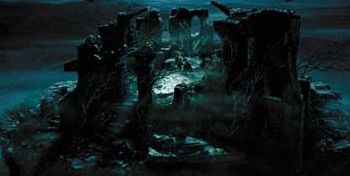 Watch-tower
on Weathertop. Weathertop - which was
also called Amon Sul - was the southernmost of the Weather
Hills. It was located north of the Great
East Road in Eriador. The Tower of Amon
Sul was once tall and fair, but by the end of the Third Age only ruins
remained.
Watch-tower
on Weathertop. Weathertop - which was
also called Amon Sul - was the southernmost of the Weather
Hills. It was located north of the Great
East Road in Eriador. The Tower of Amon
Sul was once tall and fair, but by the end of the Third Age only ruins
remained.
The Tower of Amon Sul was built in the first days of the North-kingdom of Arnor, which was founded in 3320 of the Second Age. At that time, the seven palantiri were divided and placed in different parts of Gondor and Arnor. The largest and most powerful palantir in the North was kept in the Tower of Amon Sul. The Stone of Amon Sul was the chief palantir used for communicating with Gondor. The palantir was kept on a round table of black marble with a curved depression in the surface where the seeing-stone was set.
It was said that Elendil watched from the Tower of Amon Sul for the arrival of Gil-galad before they set out to fight Sauron in the War of the Last Alliance.
When Arnor was divided into three kingdoms in 861 of the Third Age, the Tower of Amon Sul was claimed by Arthedain and a special warden was posted there to guard and maintain the palantir. But Cardolan and Rhudaur also wanted possession of the Tower and its seeing-stone and there was strife among the three kingdoms.
In 1356, King Argeleb I of Arthedain was slain defending the Weather Hills against an assault from Rhudaur, which was then ruled by an evil lord of the Hillmen who had secretly joined forces with the Witch-king of Angmar. Arveleg I, son of Argeleb, drove back the invaders and defended the Weather Hills for many years. But in 1409, Weathertop was surrounded by a great host from Angmar. Arveleg was killed and the Tower of Amon Sul was burned and razed. The Stone of Amon Sul was rescued by the forces of Arthedain, but it was later lost at sea.
Over time the ring of stones that had once been the foundation of the Tower of Amon Sul crumbled and became overgrown with grass. When Gandalf came to Weathertop on October 3, 3018, he was besieged by the Nazgul in the ruins. There was a great battle on the hilltop, and when he escaped Gandalf left a cairn of broken and burned stones in the center of the ruins. Gandalf marked the topmost stone with the G rune and three strokes to indicate that he had been there on October 3.
Aragorn interpreted the message when he came with the Hobbits to Weathertop on October 6. Later that night in a dell on the western side of Weathertop, five Nazgul attacked and Frodo Baggins was gravely wounded by the Witch-king before the Nazgul withdrew and Aragorn led the Hobbits away.
Names &
Etymology:
Amon Sûl was the Sindarin
name for Weathertop. It means "Hill of the Wind" from amon meaning
"hill" and sûl meaning "wind."
Sources:
The Fellowship
of the Ring: "A Knife in the Dark," p. 197-200; "The Council of Elrond,"
p. 277
The Two
Towers: "The Palantir," p. 203
Appendix
A of The Lord of the Rings: "The North-kingdom and the Dunedain," p.
320, 322
Unfinished
Tales: "The Palantiri," p. 409, 411, 413
"Nomenclature
of The Lord of the Rings," entry for Weathertop
Tower of Cirith Ungol |
The
Tower of Cirith Ungol by Alan Lee
|
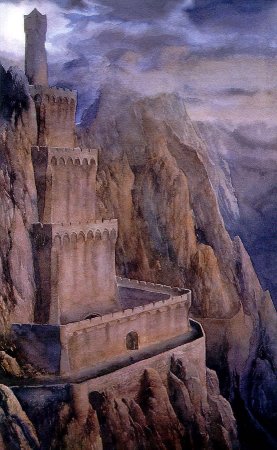 Watchtower
on the border of Mordor. The Tower of Cirith
Ungol was located high in the Mountains of Shadow overlooking the pass
that was called Cirith Ungol - the Pass
of the Spider - because the Great Spider Shelob
dwelled there. At the top of the pass was a cleft with two great horns
of rock on either side. On the northern horn stood the Tower of Cirith
Ungol, built up against the eastern face of the rock.
Watchtower
on the border of Mordor. The Tower of Cirith
Ungol was located high in the Mountains of Shadow overlooking the pass
that was called Cirith Ungol - the Pass
of the Spider - because the Great Spider Shelob
dwelled there. At the top of the pass was a cleft with two great horns
of rock on either side. On the northern horn stood the Tower of Cirith
Ungol, built up against the eastern face of the rock.
The Tower of Cirith Ungol was made of black stone. It had three tiers, each set back from the next like steps. The sheer sides faced northeast and southeast and formed a bastion pointing eastward. At the top of the Tower was a round turret that could be seen above the pass.
A road ran down from the pass and skirted the Tower alongside a sheer precipe before turning southward to join the Morgul Road. The Tower of Cirith Ungol was surrounded by an outer wall that was 30 feet high. The sides of the wall were smooth at the top was overhanging stonework that prevented anyone from climbing over it.
The main gate was in the southeastern side of the wall. It was guarded by the Two Watchers - hideous statues seated on thrones. Each Watcher had three joined bodies facing inward, outward, and toward the other. The heads were like vultures with black, glittering eyes. The Two Watchers created an invisible barrier between them that prevented any enemy from passing the gate.
Within the outer wall was a paved courtyard. There was a great door on the southeastern side of the Tower of Cirith Ungol. A passageway ran back through the Tower with rooms on either side. At the far end was the arched door of the Undergate - a back entrance to the Tower that opened onto a tunnel that joined with Shelob's Lair.
To the right of the Undergate was a winding stairway to the upper levels of the Tower. At the top of the stairs was a domed chamber with doors facing east and west leading out onto the roof of the third tier. The roof was about 20 yards across and was surrounded by a parapet. On the western side of the roof stood the turret of the Tower.
The turret had slitted windows facing westward and eastward through which torchlight glowed like red eyes. A winding stairway led up to a passage running through the middle of the turret. A trapdoor in the ceiling of the passage opened onto a large round chamber at the very top of the Tower of Cirith Ungol.
The Tower of Cirith Ungol was built by the Men of Gondor after Sauron was defeated in the War of the Last Alliance at the end of the Second Age. The Tower was the easternmost outpost of the defenses of Ithilien. Its original purpose was to keep watch on the land of Mordor to ensure that no evil things escaped and to guard against the possibility of the Dark Lord's return. But as Gondor's power declined - partly as a result of the Great Plague in 1636 of the Third Age - the vigilance on Mordor became lax and the Tower was deserted.
After the Lord of the Nazgul returned to Mordor in 1980, the Tower came under his control. From Cirith Ungol, he led an assault on Minas Ithil, which was captured in 2002 and became his stronghold known as Minas Morgul. Sauron returned to Mordor in 2942, and he used the Tower of Cirith Ungol to prevent any of his slaves or prisoners from escaping from Mordor. A garrison of Orcs were stationed in the Tower, and at the time of the War of the Ring their captain was Shagrat.
On March 13, 3019, Shagrat brought Frodo Baggins through the Undergate to the Tower of Cirith Ungol and imprisoned him in the topmost chamber of the turret. Frodo was stripped and questioned mercilessly. Gorbag - an Orc from Minas Morgul - coveted Frodo's mithril shirt and he fought Shagrat for it. The Orcs of their two companies fought and killed one another until nearly all of them were dead.
Sam Gamgee came to the Tower of Cirith Ungol to rescue Frodo on March 14. He got past the Two Watchers by raising the Phial of Galadriel, but once he was through the gate the Watchers gave a terrible cry and an alarm bell rang in the Tower. Sam entered the Tower and encountered Snaga, who mistook Sam for a Great Elf-warrior and fled back up the stairs. Sam followed him to the roof of the third tier. There Sam confronted Shagrat, who fled with the mithril shirt.
Sam entered the turret in search of Frodo, but he could not find a way to the uppermost chamber until he saw Snaga climb up through the trapdoor in the ceiling. He followed Snaga, and when he saw the Orc whipping Frodo he charged at him, and Snaga fell through the trapdoor to his death.
Sam returned the Ring to Frodo and they escaped from the Tower disguised in Orc armor and livery in the early hours of March 15. They used the Phial to pass the Watchers, and the archway collapsed behind them. As they fled, a Winged Nazgul descended from the sky perched on the wall of the Tower of Cirith Ungol.
Names &
Etymology:
Cirith Ungol means "Pass
of the Spider." Cirith means "pass," derived from kir meaning
"cut, cleave." Ungol means "spider," derived from ung meaning
"gloom" and ungo meaning "cloud, dark shadow." The pass was so-called
because the Great Spider Shelob had her lair there.
Sources:
The Two
Towers: "The Stairs of Cirith Ungol," p. 319-20; "The Choices of Master
Samwise," p. 342-52
The Return
of the King: "The Tower of Cirith Ungol," passim; "The Land of Shadow,"
p. 193
The Silmarillion:
"Appendix - Elements in Quenya and Sindarin Names," entry for kir
The History
of Middle-earth, vol. V, The Lost Road and Other Writings: "The Etymologies,"
entry for UNG
Tower of Ecthelion |
The
Tower of Ecthelion by John Howe
|
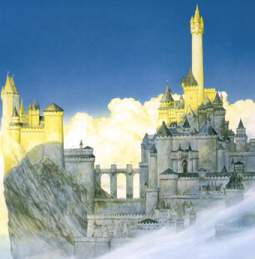 White
Tower of Minas Tirith. The Tower of Ecthelion
was 50 fathoms (300 feet) tall. The plain white standard of the Stewards
of Gondor flew from its pinnacle. The Tower stood
in the center of the Citadel on the seventh level
of the city. In front of the Tower was the Court of the Fountain where
the White Tree of Gondor grew.
White
Tower of Minas Tirith. The Tower of Ecthelion
was 50 fathoms (300 feet) tall. The plain white standard of the Stewards
of Gondor flew from its pinnacle. The Tower stood
in the center of the Citadel on the seventh level
of the city. In front of the Tower was the Court of the Fountain where
the White Tree of Gondor grew.
In the Tower Hall was the throne of the King of Gondor upon a dais, and at the foot the dais on the lowest step was a black chair where the Steward of Gondor sat. There was a chamber high in the Tower and above it in the summit there was a secret room where the palantir of Minas Anor called the Anor-stone was kept.
The White Tower was first built by King Calimehtar in 1900 of the Third Age in order to house the palantir. In 2698, the Tower was repaired and rebuilt by the Steward Ecthelion I, for whom the Tower came to be named.
The elite military unit in Minas Tirith was called the Guard of the Citadel or the Guard of the Tower of Gondor. At the time of the War of the Ring, Boromir and Faramir - the sons of the Steward of Gondor - each bore the title Captain of the White Tower. Boromir, the Steward's heir, was also the High Warden of the White Tower.
On March 9, 3019, Peregrin Took got his first glimpse of the Tower of Ecthelion as he rode with Gandalf to Minas Tirith:
Then Pippin cried aloud, for the Tower of Ecthelion, standing high within the topmost wall, shone out against the sky, glimmering like a spike of pearl and silver, tall and fair and shapely, and its pinnacle glittered as if it were wrought of crystals; and white banners broke and fluttered from the battlements in the morning breeze, and high and far he heard a clear ringing as of silver trumpets.Pippin met Denethor, the Steward of Gondor, in the Tower Hall. Denethor's son Faramir came to the Tower Hall the next day and Pippin and Gandalf learned of his encounter with Frodo and Sam. When Faramir was brought back to the city gravely wounded on March 13, Denethor retreated to his chamber high in the Tower with his son and would not come down. In the secret chamber of the Tower, Denethor looked into the palantir and saw images manipulated by Sauron that caused him to despair.
The Return of the King: "Minas Tirith," p. 23
After the War of the Ring on May 1, the standard of the Stewards of Gondor was raised for the last time. That day Aragorn was crowned King and when he entered the Citadel, the standard of the Kings of Gondor bearing the Tree and the Stars was unfurled on the pinnacle of the Tower of Ecthelion.
Names &
Etymology:
Also called the White Tower.
It was renamed the Tower of Ecthelion after the Steward Ecthelion
I who rebuilt it. Also called the Tower of Denethor during the reign
of Denethor II.
Sources:
The Two
Towers: "The Departure of Boromir," p. 19; "The Palantir," p. 206
The Return
of the King: "Minas Tirith," p. 23-26 and passim; "The Muster of Rohan,"
p. 73; "The Siege of Gondor," p. 91-92, 94-95, 97, 98-99; "The Pyre of
Denethor," p. 129, 131, 132-33; "The Steward and the King," 244, 246
Appendix
B of The Lord of the Rings: "The Tale of Years," p. 367, 369
The History
of Middle-earth, vol. XII, The Peoples of Middle-earth:
"The Heirs of Elendil," p. 200
The Lord
of the Rings: A Reader's Companion by Wayne G. Hammond and Christina
Scull: "The Departure of Boromir," p. 361
Towers of the Teeth: Narchost & Carchost |
The
Towers of the Teeth by Alan Lee
|
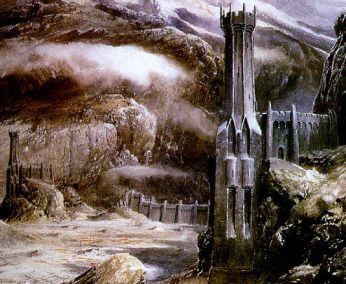 Towers
flanking the Black Gate of
Mordor.
The Towers of the Teeth stood on either side of Cirith
Gorgor, the Haunted Pass between the Mountains
of Shadow and the Ash Mountains at
the northwest corner of Mordor. Carchost was on the east (or left facing
the Gate) and Narchost was on the west (or right). The Black Gate barred
the pass between the two towers. The towers were tall and strong and had
window-holes that faced north, east, and west.
Towers
flanking the Black Gate of
Mordor.
The Towers of the Teeth stood on either side of Cirith
Gorgor, the Haunted Pass between the Mountains
of Shadow and the Ash Mountains at
the northwest corner of Mordor. Carchost was on the east (or left facing
the Gate) and Narchost was on the west (or right). The Black Gate barred
the pass between the two towers. The towers were tall and strong and had
window-holes that faced north, east, and west.
The Towers of the Teeth were built by the Men of Gondor after the defeat of Sauron in the War of the Last Alliance at the end of the Second Age in order to guard against the possibility of the Dark Lord's return to Mordor. The towers were still in the control of Gondor as late as 1944 of the Third Age, when King Ondoher of Gondor was slain in battle against the Wainriders before the Black Gate. The Towers of the Teeth were deserted at some point after that - probably before 1980 when the Lord of the Nazgul returned to Mordor.
In 2942, Sauron returned to Mordor and the Towers of the Teeth came under his control. Sauron filled the towers with garrisons of armed guards who kept ceaseless watch on the Black Gate.
On March 5, 3019, Frodo Baggins and Sam Gamgee were led to the Black Gate by their guide Gollum. When they saw the towers and the gate that guarded the Dark Lord's realm they despaired, for it seemed impossible to enter Mordor that way. It was then that Gollum told them of a secret way into Mordor through the Pass of Cirith Ungol, and Frodo agreed to trust him.
The Host of the West led by Aragorn came to the Black Gate on March 25. There they saw the Nazgul on Fell Beasts hovering above the Towers of the Teeth like vultures. When the Ring was destroyed, the Towers of the Teeth collapsed and the Black Gate fell and Gandalf declared that the realm of Sauron was ended.
Names &
Etymology:
Also called the Teeth of Mordor,
the Towers of the Black Gate, and the Watch-towers of the Morannon.
Carchost means "Fang Fort." The word carch means "tooth, fang" and ost means "fortress." Narchostmeans "Bitter-Biting Fort." The element narch means "bitter-biting."
Sources:
The Two
Towers: "The Black Gate Is Closed," p. 244
The Return
of the King: "The Black Gate Opens," p. 163; "The Tower of Cirith Ungol,"
p. 176; "The Field of Cormallen," p. 227
Unfinished
Tales: "Cirion and Eorl and the Friendship of Gondor and Rohan," p.
293, 312 (note 15)
The Silmarillion:
"Appendix: Elements in Quenya and Sindarin Names," entry for carak
The Lord
of the Rings: A Reader's Companion by Wayne G. Hammond and Christina
Scull: "The Tower of Cirith Ungol," p. 601
All entries are Copyright © by the Thain from former tuckborough.net. Please contact me if you are Thain or know anything about how to contact the original author.
2003-2011, The Thain's Book - thainsbook.minastirith.cz
- e-mail: thain at tuckborough.net